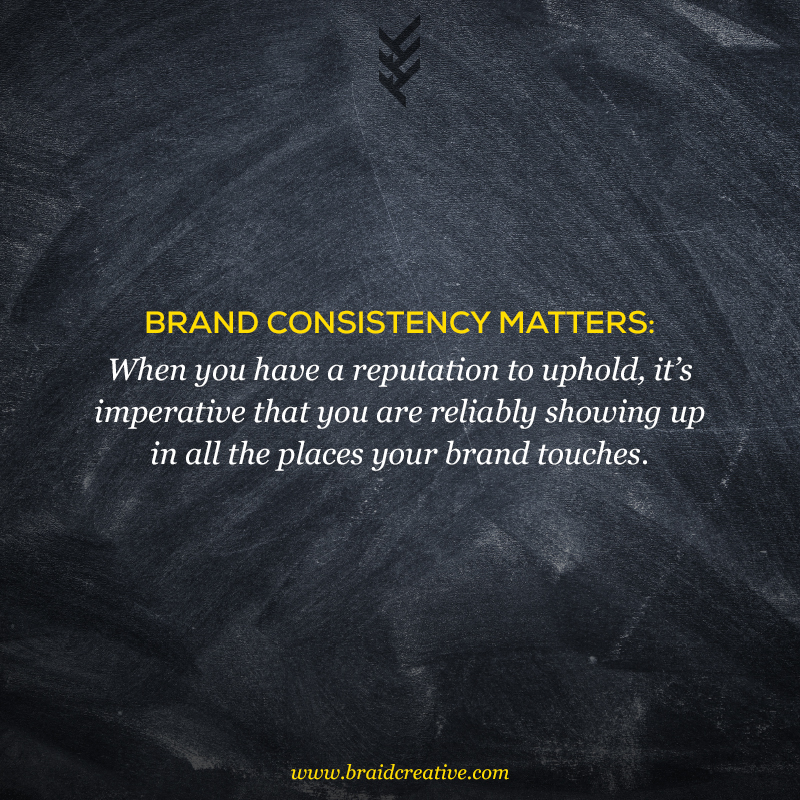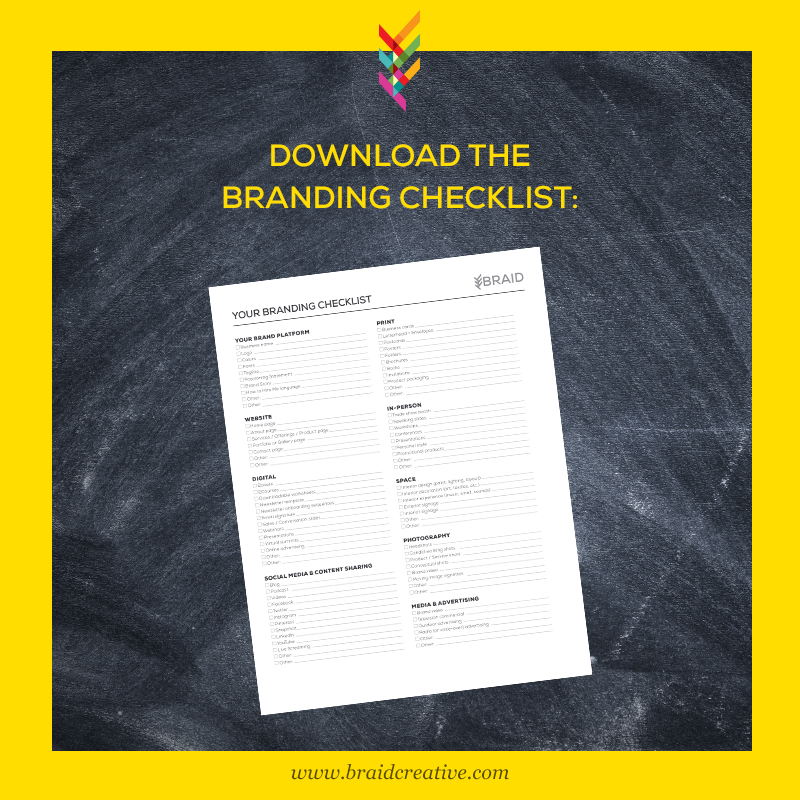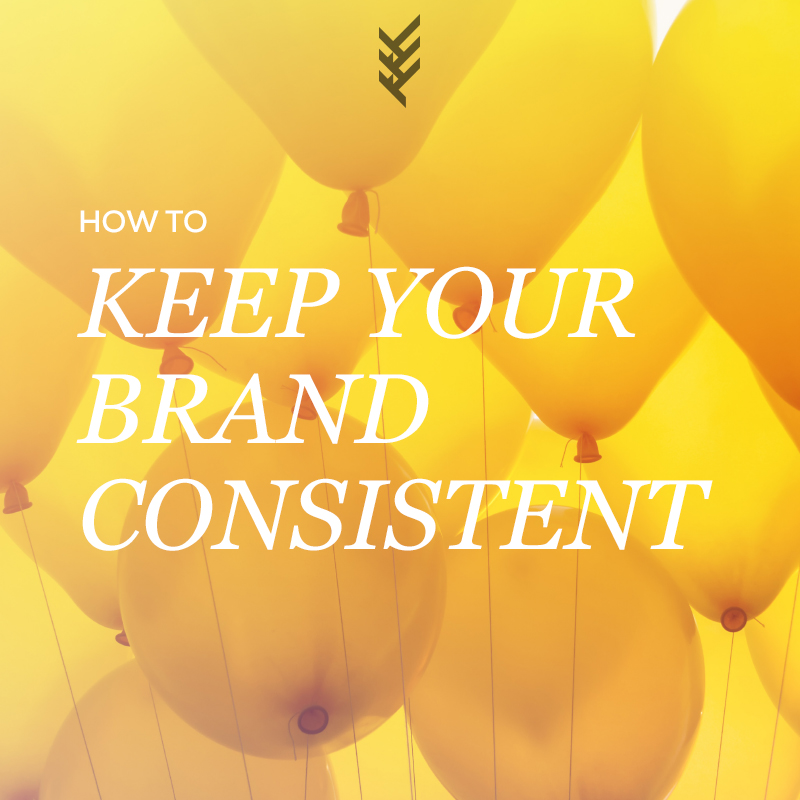Your brand is what makes you memorable—from the first impression on someone who has never heard of you, to a raving referral from a past client. And when you have a reputation to uphold, it’s imperative that you are reliably showing up in all the places your brand touches. This means that your business name, logo, colors, photography, tagline, offering, messaging, and tone are consistent and cohesive on your website, in your advertisements, on your stationery and print materials, on your social media, in your speeches and talks, on your windows and signage, at your events, or in your webinars. It should even reach into your own company culture— not only in how you make your customers feel, but in how you train your employees and how you work with contractors and vendors.

IT BEGINS WITH A BRAND PLATFORM
One of the first steps to creating a consistent and cohesive brand is with a brand platform that outlines at-a-glance who you are, what you do, how you do it, and what it looks like. Here at Braid Creative, the brand platforms we create for our clients often include:
Brand identity standards: this is a document that details all the visual components of your brand—including your logo (or logo suite if you have multiple versions), brand colors, typography and fonts, branded icons and / or patterns, and brand photography.
Brand messaging: this is anything with words—including your business name, a tagline, a positioning statement (often known as an “elevator pitch”), a brand story that connects the emotional “why” to the business offering, scripts or copy for how someone can work with you, and your creative process or steps you take along the way.
Your brand platform is the backbone of your brand that can then be applied to all the places your business shows up. You’ll want to revisit your brand platform any time you’re creating something new for your business—from marketing and PR efforts to client on-boarding.
TAKE STOCK OF ALL THE PLACES YOUR BRAND SHOWS UP
Once you have your brand platform visually defined and outlined, it’s time to implement that look, feel, and messaging to all the places your brand shows up. The first thing you’ll want to do is take stock of where you’re showing up.
ONLINE & DIGITAL:
Website – make it a habit to read through every single word on your website at least once a year to make sure your design and copy are still properly reflecting your brand and business offerings.
Social media – not only in your daily posts that make up your ever-evolving brand, but your avatar, cover image, and profile copy are also opportunities for consistency and cohesion.
Email – from your newsletter template to your email signature and even your actual email address—no little detail should go unturned when it comes to where your brand appears
Digital products – if you have online courses, downloadable worksheets, or eBooks, they should all be consistent with your brand platform.
Digital advertising – from TV commercials to Facebook ads to native content and PR opportunities, you need to make a compelling impression that accurately reflects your brand so there are no disconnects when your dream customer clicks through wanting more.
PRINT:
Stationery – are your business cards, letterhead, and envelopes up to date and on point?
Brochures, folders, posters, books, and informational pieces – all of these are branded pieces that need to feel connected and consistent with your brand platform.
Packaging – if you sell products, is your packaging delivering the experience you want your customers to have?
IN PERSON:
Spaces and events – when it comes to in-person events, think about engaging all the senses of anyone who experiences your brand: what are they seeing, smelling, tasting, and hearing? These are often things that aren’t defined in your brand platform (especially if you’re primarily an online business), but they are considerations that can make or break an experience for your customer.
Signage and touch-points – from your logo signage, to window clings, to car wraps, to informational or directional signage, and even printed memos, these tactics—no matter how small—are deserving of brand consideration.
Your personal style – if you’re a personal brand, the way you show up to networking events is a reflection of your brand. If you’re not a personal brand, you (or the employees you are hiring) are a reflection of the company you represent.
PHOTOGRAPHY:
Photography is an aspect of your brand that can show up across all of your brand platforms in person and online. Photos can really set the tone for your brand, and as you know—a picture speaks a thousand words. We always recommend a series of photos for our clients including headshots and candid working photos that help make the work you do feel real (especially if you are a consultant, educator, or coach), styled shoots for products or services, and conceptual or environmental images to help illustrate brand stories or style beyond the literal. We recommend hiring a photographer once a year for a branded shoot—including updated headshots and supplementing with stock photography that is treated with your brand standards in the interim.
YOUR CUSTOMER’S EXPERIENCE IS A ROAD MAP FOR YOUR BRAND
Once you’ve been able to take stock of all the places your brand shows up, it’s time to audit and assess what needs to be updated to reflect your most current brand standards and identity. I recommend prioritizing the entry point for a customer and using their next steps as a map to determine what needs your attention next.
For example, if you are selling an educational course and are running a Facebook ad campaign, the ads will be the first thing your customer sees. Those ads need to make an impression that is consistent and cohesive with what they’ll see next—which is probably a landing page to your course or your website. From there, they may sign up for your newsletter or a series of free training to learn more.
Or perhaps you are a leadership coach who is giving a talk at a conference. Your slides, your talk, and your personal style will make the first impression for your brand. From there, your audience may try to find you on Twitter or Instagram so they can tag you with quotes from your speech. Then, they may buy your book or sign up for your newsletter.
The experience your customer is having is a road map that will show you which stops or turns your customer can take next. You’ll want to be sure you always know which direction they’re headed so there are no brand disconnects or confusion along the way.
HOW DO I MAKE IT ALL LOOK GOOD?
Okay, so by now you’ve assessed and audited all the places your brand lives, and you know how and where your potential customer is engaging with your brand along the way. Now it’s time to make sure all the pieces look consistent and cohesive with your brand platform and with each other.
My best recommendation is to hire a graphic designer and copywriter—ideally the person or team who helped you establish your brand in the first place—to implement your brand platform on all the pieces and places your brand shows up. If it’s the person who initially created your brand, you can trust them to make decisions on the fly when it comes to how your brand is applied across different platforms. If you’re working with a freelance designer or copywriter, you may need to give them more direction until they’re more familiar with the look, feel, and tone of your brand.
When you’re working with a designer and / or writer, the more you can batch your projects together, the more efficient you can be with your budget and time—though this means you’ll need to be more organized with your marketing efforts. However, if you develop an ongoing relationship with a designer or have someone on retainer, you can throw projects their way as they come. It really just depends on your needs and style.
Now the DIY-control-freak in me wants to tell you that you can learn to do it yourself, but I’ve seen too many people butcher their beautiful brand by trying to become a graphic designer instead of focusing on their core genius. It might be a little bit of an investment to hire help, but I promise it will save you money in the long run.

YOUR BRANDING CHECKLIST
The point of this worksheet is to help you assess and audit all the places your brand exists. It’s for you to use however you like, but I recommend:
- Cross out anything that is not applicable to your brand
- Highlight or circle any high-traffic touch points
- Check the boxes to the left after you’ve checked in on those parts of your brand. That check in might be a series of questions including but not limited to:
- Which tactics have the most impact on my business?
- Is this consistent?
- Could I systemize this?
- Can I delegate this?
- Where are there disconnects or inconsistencies?
- What’s working well? What do I like about this?
- Use the space to the right to make notes on what needs to be updated or refined
You can also use this worksheet to help you decide which tactics you can add or omit from your brand and even use it as a checklist to know what you need to delegate.
DOWNLOAD THE BRANDING CHECKLIST WORKSHEET – NO EMAIL REQUIRED!
And if you would like to get our articles, worksheets, and checklists straight to your inbox subscribe to our newsletter below.

